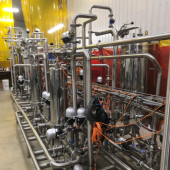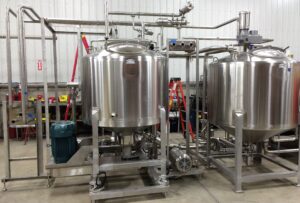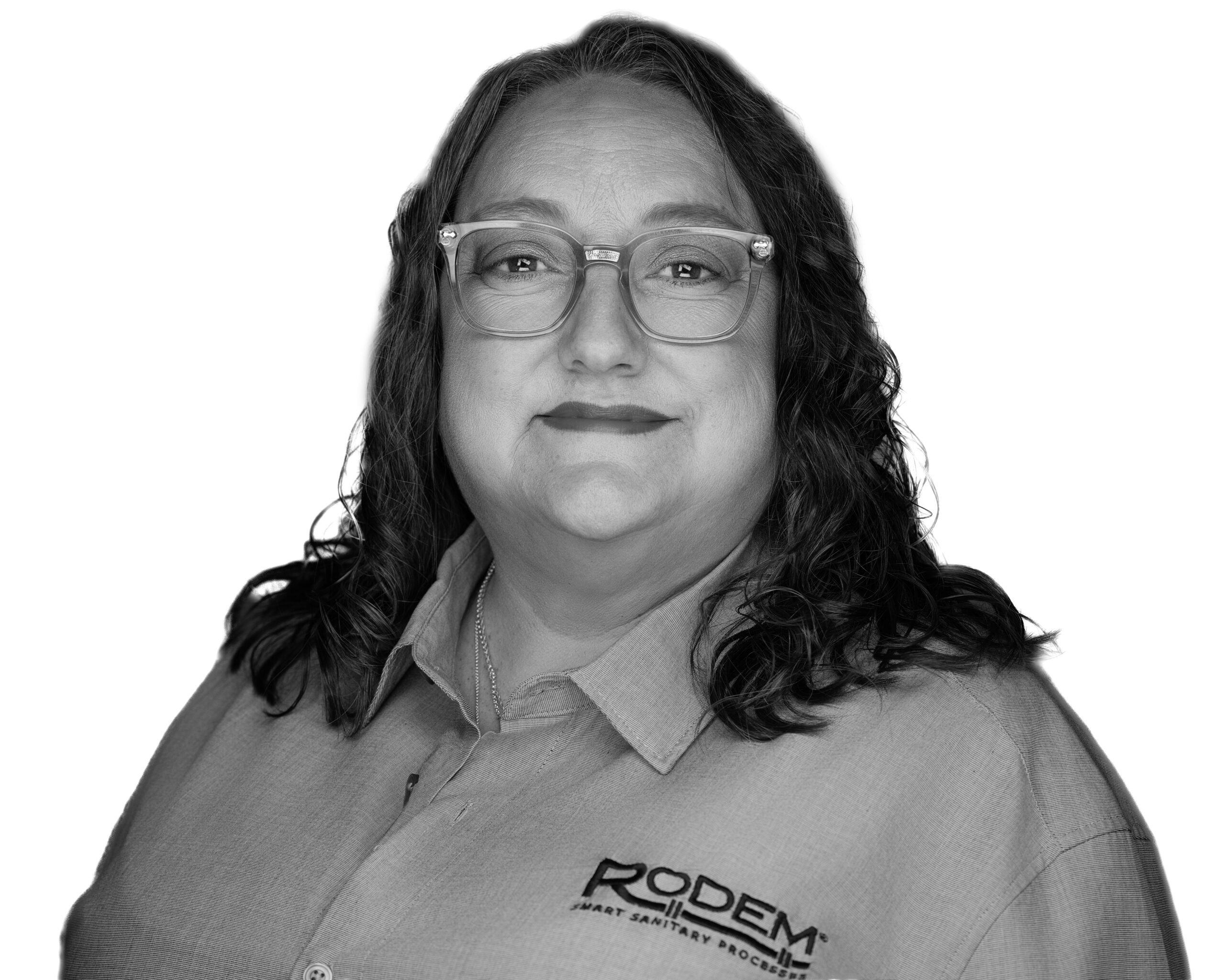
For manufacturers looking to scale up sanitary processes without disrupting production schedules skid construction can be an ideal solution. Designed to house an entire process or individual application, modular skids can have a big impact on processing efficiency too. A skid can range from something as simple as a pump on a cart to a complex custom tailored clean in place skid system.
This article will cover the common types of sanitary processing skid systems and their uses. Because skid construction is completely customizable skid systems can be built to meet nearly any dairy, food or beverage processing demand.
Clean in place solutions or CIP is a method of cleaning by running cleaning fluid through processing equipment, piping and tanks to remove soils leftover from production. The CIP skid system houses all the components required to run CIP cycles. Each customized clean in place skid can vary slightly in design, but all contain essential components like tanks, pumps, temperature and flow instrumentation, valves, tubing and heating elements.
Like any cleaning application, clean in place solutions rely on the basic principles of cleaning: temperature, chemical reaction, time and mechanical force. With the wide variety of areas, that requiring cleaning within a processing plant each set of piping, tanks and processing equipment must be evaluated independently. Depending on the application the principles can be adjusted to create a one-of-a-kind clean in place skid to meet the product requirements.
Industries that require the highest level of hygiene rely on CIP skid systems, including beverage, dairy, brewing, pharmaceuticals, cosmetics and processed foods. Incorporating clean in place solutions through a CIP skid system is not only minimally disruptive to tie into an existing process but delivers faster and less labor-intensive cleaning, repeatable resulting and consistently high cleaning quality. Processors can further enhance the benefits of their clean in place skid through automation.
There are many considerations to account for when designing a CIP skid system and process such as line flow velocity, soil levels, process conditions, size and location of tanks, equipment size and more. Consult a sanitary cleaning expert to see what works best with your process, requirements and desired outcome.
Steam in place, or SIP is a commonly used process of utilizing thermal energy of condensing steam to eliminate organisms and sterilize a processing system in food, beverage and other high purity processing industries. Similar to clean in place solutions, steam in place is intended to cleanse and sterilize processing equipment without disassembling it. A CIP cycle is required prior to steam in place to remove soils prior to sterilization and is used in cleaning applications when clean in place solutions are not enough.
Skid construction for steam in place systems can be customized to meet specific process or product requirements. Effective sterilization with a steam in place skid system is highly dependent on the process reaching and maintaining specific temperatures.

Filtration skids are a critical part to maintaining product integrity and safety for sanitary processors. They are used to filter particles and fluid for various products during production. Separation skids separates a mixture or solution into two or more different products.
Because they are built off-site filtration and separation skids construction can be integrated into an existing system quickly and result in immediate impact on overall processing efficiency. It is important to understand what is happening upstream and downstream as well as overall processing goals before designing a filtration or separation skid.

A high quality product requires the right combination of ingredients partnered with precise processing, mixing and blending. Skidded mixing and blending solutions combine engineering and equipment to deliver a compact, easy to install, turnkey option for food, beverage and other high purity processors.
Skid construction is an ideal option for processers seeking to scale up manufacturing quickly. Offsite construction reduces delays and minimizes disruption. Mixing and blending skids can be completely customized to offer a variety of solutions including continuous blending, high shear mixing, powder/liquid blending or emulsifying.
Skid construction for sanitary processors is steadily gaining popularity over traditional processing systems. Beyond CIP skid systems, steam in place, filtration, separation, mixing and blending skids, a modular skid construction can be utilized for ozone, isotonic, aseptic processing and hot fill skids. From individual applications to entire processes, the options are limitless.
Rodem’s goal with modular skid construction systems is to maximize efficiency and yield, while minimizing downtime and keeping great sanitary design in mind.
Rodem’s SaniSmart Solutions team can design, build and install a system with minimal impact on processors tight production schedule. Talk to your Rodem contact to learn more about skidded systems.

E-mail: [email protected]
Copyright 2024 Rodem Inc. All rights reserved.
